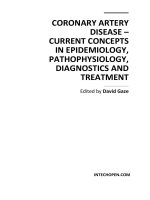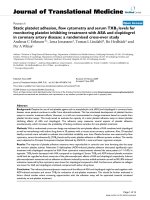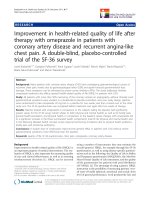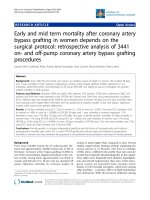coronary artery systolic milking and bridging in takotsubo syndrome substrate or an epiphenomenon
Bạn đang xem bản rút gọn của tài liệu. Xem và tải ngay bản đầy đủ của tài liệu tại đây (138.41 KB, 2 trang )
OPEN ACCESS
Letter to the editor
Coronary artery systolic “milking”
and “bridging” in Takotsubo
syndrome: substrate or an
epiphenomenon?
John E. Madias1,2,*
1
Icahn School of Medicine at Mount
Sinai, New York, NY
Division of Cardiology, Elmhurst
Hospital Center, Elmhurst, NY
2
*Email:
To The Editor:
I enjoyed reading the case report by Spadotto et al.1 published in issue 2 (2013) of the Journal about a
66-year-old woman with Takotsubo syndrome (TTS), involving the mid-apical segment of the left
ventricle (LV), severe dynamic mid-ventricular gradient and mitral regurgitation, with systolic anterior
motion of the anterior mitral leaflet caused by the hyperkinetic basal segments, with generation of a
peak intra-ventricular gradient of 48 mmHg, and mild systolic “milking” of the mid to distal segment of
the left anterior descending coronary artery (LAD). Cardiac magnetic resonance imaging (cMRI)
showed intense myocardial edema of the mid-apical LV segments. The authors cite their previous
report of “a recent clinically based study (which) showed that myocardial bridging of the LAD artery
was detected in 76% of TTC patients either by angiography or MSCT”.2 It is conceivable that this out
of proportion high rate of “bridging”, and the occasionally reported systolic “milking” of the LAD in
patients with TTS is due to an interplay of hypercontractility of the LV and the myocardial edema,3
present in this condition. The issue can be easily resolved by coronary angiography (CA) (or MSCT),
performed prior or after a bout of TTS in patients, who had/have a clinical indication for such a study,
before or after their episode of TTS. In other words I am in doubt of the authors’ previous explanation
that “myocardial bridging of the LAD is a frequent finding in TTS patients as revealed both by CA and,
mostly, by MSCT, suggesting a role of myocardial bridging as potential substrate in the pathogenesis
of TTS; probably this is an epiphenomenon of TTS state rather than an existing substrate prion to
the inception of the TTS.
Conflicts of Interest Disclosure
There is nothing to disclose.
/>10.5339/gcsp.2014.16
Submitted: 4 April 2014
Accepted: 9 April 2014
ª 2014 Madias, licensee
Bloomsbury Qatar Foundation
Journals. This is an open access
article distributed under the terms
of the Creative Commons
Attribution license CC BY 4.0, which
permits unrestricted use,
distribution and reproduction in any
medium, provided the original work
is properly cited.
REFERENCES
[1] Spadotto V, Elmaghawry M, Zorzi A, Migliore F, Marra MP. Apical ballooning with mid-ventricular obstruction: the many
faces of Takotsubo cardiomyopathy. Glob Cardiol Sci Pract. 2013;2013(2):163 –168, />2013.22.
[2] Migliore F, Maffei E, Perazzolo Marra M, Bilato C, Napodano M, Corbetti F, Zorzi A, Andres AL, Sarais C, Cacciavillani L,
Favaretto E, Martini C, Seitun S, Cademartiri F, Corrado D, Iliceto S, Tarantini G. LAD coronary artery myocardial bridging
and apical ballooning syndrome. JACC Cardiovasc Imaging. 2013;6(1):32–41, />08.013.
[3] Perazzolo Marra M, Zorzi A, Corbetti F, De Lazzari M, Migliore F, Tona F, Tarantini G, Iliceto S, Corrado D. Apicobasal
gradient of left ventricular myocardial edema underlies transient T-wave inversion and QT interval prolongation
(Wellens’ ECG pattern) in Tako-Tsubo cardiomyopathy. Heart Rhythm. 2013;10(1):70–77, />j.hrthm.2012.09.004.
Cite this article as: Madias JE. Coronary artery systolic “milking” and “bridging” in Takotsubo
syndrome: substrate or an epiphenomenon? Global Cardiology Science and Practice 2014:16
/>
Copyright of Global Cardiology Science & Practice is the property of Bloomsbury Qatar
Foundation Journals and its content may not be copied or emailed to multiple sites or posted
to a listserv without the copyright holder's express written permission. However, users may
print, download, or email articles for individual use.









